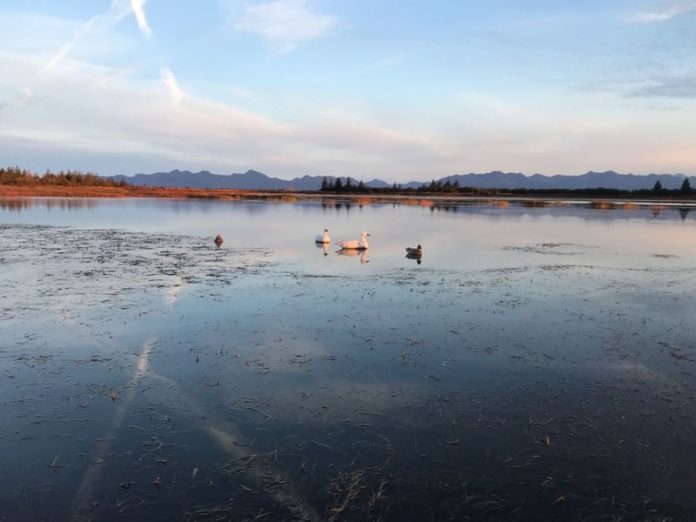
The days are becoming shorter, and waterfowl are banding up for their migration to warmer climes.
Out on the Copper River Delta, a sure sign it is time to move on is ice on the ponds and bitter dust-filled winds howling down the Copper Rive
Experience has taught that long strings of trumpeter swans honking melodiously accompanied by rows of green-headed mallards with four curls on their tails means another fall hunting season is about over.
There is a reason for the phrase “swan song.”
Having listened to the peal of these massive white birds for over six decades, the only regret I have about their departure is the choice of musical instrument to describe their call, but “tromboning” swans just doesn’t have the right ring to it.
All these thoughts passed through my mind while watching a growing number of swans gathering in the north arm of Eyak Lake. After being covered with skim ice, the lake had opened up, and several hundred trumpeters were feeding away. Dabbling with their tail ends in the air, they can reach vegetation on the bottom, which surely shows how much the lake is gradually silting in.
There actually is a significant number of swans that tough it out through the winter, congregating in the open waters near the Eyak River bridge even without the enticement of now deceased old-timer Ed King feeding them barley he had shipped down from Delta, Alaska.
A happenstance experience while taking an early morning walk along Power Creek Road reminded me of another reason they can make it through the winter.
I had paused to watch a nearby pair of swans and their reflections gliding by on flat calm waters, when right below the road bank in front of me a startled bald eagle sprang aloft. He likely had been feeding on decaying salmon carcasses.
Eagles are not quick to gain altitude and he flapped by the swans at eye level.
Amazingly, the swans didn’t even blink nor honk nor bother turning their heads when this large predator went flying by. Maybe over eons of evolution the two species have reached some sort of agreement.
After all, a mature trumpeter can weigh more than 25 pounds, and reach a length of over 6 feet, with a wingspan of 8-10 feet.
Mature bald eagles average 9 pounds, with length 28-38 inches, and wingspan of 6 feet.
So, it’s a mismatch to start with.
And then there’s the issue of what to do next for an eagle that is successful with its attack.
Consider this.
“It’s common for them (eagles) to get a hold of a fish that’s too heavy to fly with …they can’t take off but they can tow it to shore, rowing with their wings,” said U.S. Fish & Wildlife Service specialist Mike Jacobson. “They’re pretty good swimmers. They have thick down so they float pretty well. Occasionally they’ll drown if they’re too far from shore.”
Can you imagine an eagle trying to tow a battling swan across Eyak Lake?
They will have to settle for rarely successful diving attempts at ducks or seagulls on Odiak Slough in front of our house or elsewhere.
So swans can scratch eagles as a reason to not winter here.
And continue to entertain us with their “tromboning.”
This story originally ran in the Nov. 24, 2023 issue of The Cordova Times.














